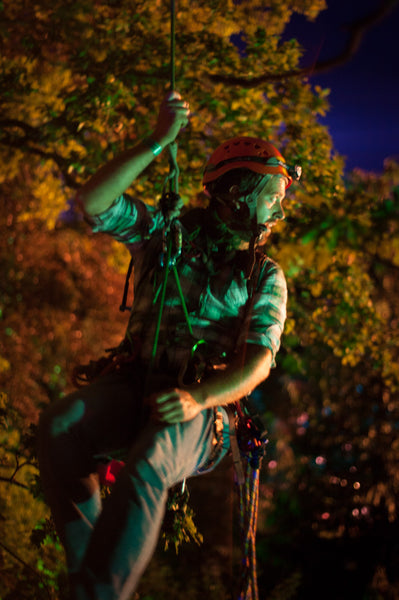When we spoke to Ben Trevor, AKA Tree Top Troubadour, about combining his arboreal and musical talents, we also asked him a couple of key questions about just what life is like when your work takes you up into the trees every day. His answers were so inspiring, we decided they deserved their own blog post. Enjoy...
Can you describe how it feels to work up in the trees?
Climbing trees for leisure, or as a platform for performing music, is possibly one of the most beautiful, peaceful states of being possible. The sense of connectedness to nature when you attain fluid movement through a tree is on a par with surfers catching the perfect wave or hang gliders on a thermal. When I talk about Tree Top Troubadour, people assume it's a high-energy, fast-paced pursuit, but while it does take some energy to ascend and move around a tree, the overwhelming sensation for me is of calm and contemplative quietude.
The everyday work of an arborist in a commercial work scenario, however, is an altogether different and hugely focussing experience, although also with its moments of stillness. My mind is generally a typhoon of noise and fleeting ideas and the only time I ever feel completely still and 100% focussed is when carrying out certain operations in the cutting of trees.

The pruning of a tree - a full crown reduction, for instance - is the most mentally taxing, taking a great deal of concentration and physical exertion, as you are required to climb to every extremity of the tree and make countless decisions on where to cut based on aesthetics, health and future structural integrity. To me, dismantling or removal of trees, though increasingly taxing ethically, is a far simpler, more mechanical process with only one ultimate conclusion. It does pose a greater threat to safety as there is generally a far greater weight of timber moving through the air at any given time.
So, you're standing maybe 50ft up the main central stem of a tree on 'spikes' - shaped metal attachments that sit, like a stirrup, from the outer edge of your foot, under the arch, extend up the inside of your lower leg and are strapped to you just below the knee and around your ankle. There is a small point, about two inches long, that protrudes diagonally from the metal frame just below your inner ankle and is driven into the tree and acts as the point of support upon which you stand. You have dismantled every limb below you back to the main stem, so you're essentially standing almost at the top of a long straight stick with the last section of foliage at the very top. You have a rope and lanyard that are wrapped together around the stem you're standing against and attached at each hip point of your harness. Your weight pulling back against these and pushing down into the spikes, hold you steady and in place.
The top twenty feet of the tree stands above you with a pull rope attached under tension, and you have made your directional 'gob' cut - a wedge cut out of the stem, a quarter to a third of the way through, that enables a 'hinge' of wood to determine, to some extent, which direction the top section of the tree will fall once the final back cut has been made. If a substantial section goes awry and falls towards you, you have nowhere to go to escape and will be caused potentially fatal injury. You call out to check all's clear on the ground, get the thumbs up from the ground crew and begin your back cut.
This is the moment of stillness. Despite the physical movements of the tree your mind is locked to that single operation and every sense is at its highest state of acute awareness and every crack, splinter and percussion of tree fibres breaking as the section starts to tip over is logged and analyzed for any evidence of potential success or failure. It's an exquisite, slow-motion moment when you know you've done everything you can to guide the outcome but now the hands of fate and fortune have control. Then, the top is at the bottom, it lands right on target, the crew get to work cutting and tidying up and you can enjoy a few moments of triumph. I always take a few seconds to breathe, look around and feel very alive after a moment like that!

What do you think is the most important thing individuals can do to help trees and forests survive the threats currently facing them?
Above all, I think we all need to be more mindful of the products we're buying and try to open ourselves up to the sometimes difficult issues being caused by an increasingly consumerist society. We need to take a little bit more time to find out where products are coming from and what kind of impact their production has on specific environments. There are great websites that can tell you which brands are more ethical and which should be avoided.
Sharing information is vitally important, too - don't be afraid to let your newsfeed know if you've found out something disturbing regarding deforestation or unethical practices, or that a product we all know and love is having a destructive impact on habitat and communities elsewhere. We need to shake the stigma that any conservation based news is exclusively the territory of 'Sandal wearing lentil eaters' as I've heard it described!
On a more local level - why not plant a tree?! At the company I work for we've begun an initiative to plant 1000 trees a year, and we offer to replant a tree free of charge for every tree we have to take down. Also, we'll be attending trade shows and events over the summer and giving out 100 trees per show in the hope that it will develop a more nurturing intention in the public consciousness.
Just taking the time to find out the species of the trees in your street or local park will begin a 'snowball' effect of interest in you that will only develop into a need for a broader knowledge regarding trees. The destruction of forests, and the rate at which they're being destroyed, is panic-inducing to anyone who looks into it. The trouble is, the wider public aren't aware enough of what it means and how it can be avoided, and finding a way of getting the message across is really difficult. With the Tree Top Troubadour campaign, the idea is to offer a concept that is surprising and entertaining above all, and the message just comes with it.
My hope is that the beauty and vital importance of trees to our survival will reveal themselves naturally within what I say and sing, without me having to get preachy, because people tend to zone out and put up barriers if they feel they're being lectured, no matter how righteous the cause. I hope people will begin to value trees out of love and genuine care as opposed to guilt. This really needs to happen because, the fact is, what we're facing is no longer reserved for 'Eco-Warriors' or professional conservationists lobbying policy makers, it's here, and real for everyone. The problem is knocking on our collective front door, while its boys are coming round the back with bats and balaclavas!
To keep an eye on Ben's adventures, follow him on Facebook, Twitter and Instagram, or check out his website at http://www.treetoptroubadour.com/

